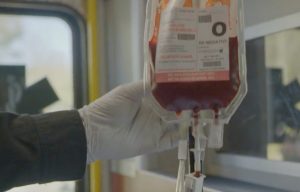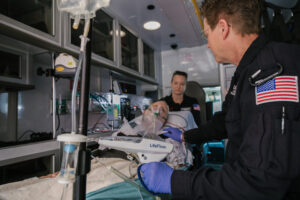
Providing evidence-based, high-quality prehospital care can mean the difference between a good outcome and a bad one–especially when it comes to patients in shock. That’s why the best EMS systems are seeking effective ways to deliver safe and effective fluid or blood resuscitation to patients who need it most.
The Problem
Shock is both one of the easiest and most difficult conditions to treat in prehospital medicine. In some ways it seems easy. The goals are to maintain perfusion and keep the patient warm–fluid resuscitation and blankets aren’t exactly difficult treatments for paramedics to administer. Clearly, it can get much more complicated. But we also know that those simple fixes are often the ones that are neglected or performed haphazardly in the field. Blankets and normal saline (or lactated ringer’s or whichever fluid your system is using) aren’t very sexy. For decades, terms like “hang fluid” have been common in EMS, without much thought as to how, how much, and how quickly that fluid is administered.
In recent years, experts in prehospital care have recognized the problems this creates. By not paying more attention to how much fluid is administered, prehospital care providers run the serious risk of under- or over-resuscitating patients. Pressure bags can help give fluid a little faster, but are often left unmonitored, and it isn’t until transferring care at the hospital that EMS clinicians check to see how much fluid they gave. The price of pumps makes them rare in most EMS systems, plus they are more helpful for slow administration of medication than rapid infusions. For people suffering from sepsis, the lack of aggressive resuscitation may hurt their chances of survival. Patients with other conditions, from trauma to dehydration to cardiac arrest, also sometimes benefit from careful, rapid infusion of fluid.
The Solution
The EMS system in Spalding County, Georgia, doesn’t hesitate to innovate if there’s an opportunity to provide better prehospital care. That’s clear in their approach to caring for patients with sepsis.
“We see sepsis as an area where the care we deliver outside of the hospital will impact what happens in the hospital,” said Matthew Perry, director of EMS for Wellstar Spalding, the hospital system whose paramedics respond to 911 calls throughout the county and provide critical care transport. “We focus on perfusion–we know the patients need to get their 30 milliliter per kilogram bolus–and our ambulances are set up to treat shock, with a couple of different vasopressors and even blanket warmers on the units.”
So when Perry and his colleagues learned about LifeFlow at a conference, they were intrigued. “I remember thinking about what I call taking our care ‘beyond the back doors,’” he said. For Perry, “beyond the back doors” means thinking about how prehospital care impacts care for the patient once they’re no longer in the ambulance. For sepsis, giving a patient a fluid bolus during transport might not immediately fix the problem, but it buys the patient time and allows the hospital to focus on more definitive treatments, such as antibiotics.
LifeFlow is a rapid infusion device that allows clinicians to quickly give a controlled amount of fluid or blood to patients who need resuscitation. WellStar Spalding is one of several EMS and hospital systems around the country finding that LifeFlow helps them deliver the evidence-based, life-saving care they want to give to their patients.
The Orange Park Fire Department in the suburbs of Jacksonville, Florida, has been using LifeFlow as part of a study of the treatment of sepsis patients. Justin Frisbee, who works in a Level I trauma center when not responding to calls as a firefighter/paramedic, says he’s usually skeptical of new gadgets and devices for the ambulance. They’re either solving a problem that doesn’t exist or designed by someone who’s never provided care in a critical situation and they require too much time to set up or too many complicated steps to use.
“But you start to use LifeFlow, and it’s a game changer,” Frisbee says. “Because it’s literally the same amount of time to set the LifeFlow up as it is to do a pressure bag. But I’m delivering the fluids three times faster.”
It also gives you more control and more awareness as you resuscitate a patient. The simple device has a manual trigger that quickly infuses fluid, so instead of “hanging a bag” and forgetting about it, paramedics and their teams know exactly how much they’re giving, and when.“You can get so much more volume in during a short period of time,” said Joseph Marfori, MD, a board-certified EMS and emergency physician who serves as the medical director for the Alexandria Fire Department in Northern Virginia. “With LifeFlow, you actually know, every time, how much you’re giving—and how quickly.”
The Results
Paramedics in Alexandria have been using the LifeFlow since 2019 and have seen it make a big difference in patient care. The device allowed them to easily administer an average of 1,000 mL of fluid to the septic patients who needed it most, helping relieve their hypotension. The department has expanded use of the device to any patients needing resuscitation, including those suffering from cardiac arrest.
What leaders in EMS agencies using LifeFlow most often comment on is that the reaction of their paramedics has been positive once they see the difference it can make for patients.
“We would use LifeFlow with people who had altered mental status, high fevers and hypotension, and you’d start to correct that before arriving at the hospital,” Frisbee explained.
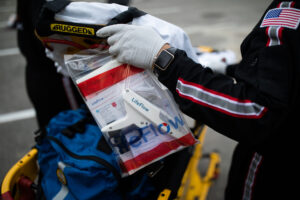 Paramedics have reported facing challenges at the hospital where nurses and physicians don’t understand how critical the patient had been in the field because they see a much-improved situation.
Paramedics have reported facing challenges at the hospital where nurses and physicians don’t understand how critical the patient had been in the field because they see a much-improved situation.
“We just had a case where the patient had an initial pressure of 73/48, heart rate of 110, end-tidal CO2 of 28, and a temp of 99.2. They got 2000mL of fluid during transport,” Perry said. By the time the ambulance arrived at the hospital, he added, “The BP, heart rate, and mental status had all improved. The patient was discharged back to the nursing home six hours later with antibiotics–they weren’t even admitted.”
In addition to using the LifeFlow to administer fluid to patients in shock, some EMS agencies have started to use the device to give blood to trauma victims. In Loudoun County, Virginia, and New Orleans, Louisiana, innovative EMS systems are bringing blood to the field. In critical trauma cases, the time saved by administering the blood immediately, rather than waiting until a patient has been transferred to a trauma bay, can make a significant difference.
Whether giving fluid or blood, EMS agencies using LifeFlow say the results haven’t just benefited patients; they’ve also impressed the EMS crews–even the ones who, like Frisbee, are sometimes skeptical of new devices.
“It got our paramedics psyched up,” Marfori said, “knowing they could make even more of a difference for our patients.”
Case #1: Two Liters in Two Miles
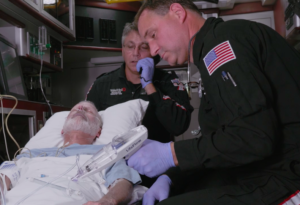
Paramedics responded to a call for a man in his 60s at a local skilled nursing facility. When they arrived, it seemed pretty clear that sepsis was likely: the man was slightly hypotensive, his heart rate crept toward 150 beats per minute, his temperature was elevated and his mental status was altered. While the department’s sepsis protocol indicated a 30 mL/kg bolus of normal saline, in the past Alexandria’s medics rarely got more than a few hundred milliliters in before arriving at the hospital. But this time was different. Using LifeFlow, the crew administered nearly two full liters during the two-mile transport to the emergency department. “His pulse went down to the 90s and his blood pressure came up into the 130s,” said one of the paramedics who treated the patient. “He was no longer diaphoretic. His improvement was significant, and the ED doctor was amazed. That is when I was convinced about LifeFlow. I was hooked.”
Case #2: An Overheated Athlete
On an unseasonably warm fall day, fire department paramedics responded to a sports complex for a 14-year-old girl at a soccer tournament. An athletic trainer said she had complained earlier of some cramping and feeling lightheaded; she had hydrated with oral fluids and tried to continue playing. But the cramping resumed and worsened, and on arrival the medics found she had visible muscle spasms in all four extremities and was barely responding. Suspecting severe dehydration, the team began evaluating her and discovered her heart rate was 170 and systolic blood pressure of 70 mm/Hg. They gained IV access during transport with a 20 gauge catheter and began infusing normal saline using the LifeFlow Fluid Infuser. In only a few minutes, a liter of fluid had been administered and the patient’s mental status and vital signs had improved. That allowed them to also administer some Ativan to help ease the discomfort from the muscle spasms. By the time they transferred care at the hospital, she was feeling better, her blood pressure had increased to 132/81, and her heart rate had decreased.
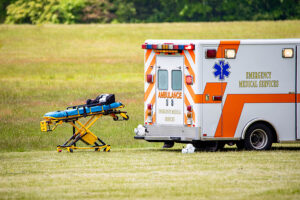
Case #3: Giving Blood
Fire and rescue personnel arrived on the scene of a serious motor vehicle crash and found a 66-year-old woman still trapped inside. She was bleeding from a large laceration, and though she was conscious after extrication, her blood pressure was 61/28, with pale skin and slow, weak pulses. The paramedics suspected a possible head injury and internal bleeding but were a little more than 30 minutes from the trauma center. The team began infusing whole blood, which the agency’s EMS supervisors started carrying in 2020. Using the LifeFlow PLUS infuser, along with a QinFlow Warrior blood warmer, they administered a unit of blood in three minutes through a humeral head IO. The patient’s blood pressure remained low, and after consulting the medical director, the EMS clinicians administered more than a liter of normal saline in just 7 minutes. Their care helped stabilize the patient, and prior to arriving at the trauma center her blood pressure had risen to 110/72, her heart rate had increased to 64, and she had improved mental status and skin color. The trauma team determined she had 2 subarachnoid hemorrhages and a concussion, and her scalp wound required 9 staples and 11 stitches to close. She was discharged walking and alert just 5 days later.
